Structural Damage Assesment for Windstorm Events#
Important
Objectives Assessing the structural damage on buildings for a storm event.
Gather windstorm footprints from Copernicus Data Store
Obtain 50mx50m European land use raster data
Explore wind vulnerability curves for buildings
Create new vulnerability curves to fit the land use data
Match the data sets so they can be used for damage calculation
Absolute and relative damage calculation! :.
Risk assessment methodology.#
This event-based windstorm risk workflow can be used to see damages of a storm by combining hazard, exposure and vulnerability. The workflow is a simplified version of the work by Koks & Haer (2020). Here the hazard is a map with the maximum 3-second wind gust of a storm. Exposure is determined by a map in which assets are associated with maximum damage that can occur per square meter of the asset and a certain exposure class is given to the asset. Vulnerability is defined as a collection of damage curves where the 3 second wind gusts are matched to a percentage of the asset that is damad
When overlaying the sets, all assets contain information on the type of asset class it is, the maximum damage that can occur at the asset, the vulnerability curve of the asset, and the windspeed at the asset location. With this information, one can do the damage calculation per asset. Step one is to inspect the vulnerability curve and how much of the asset is destroyed by the wind speed. This results in a fraction of the maximum damage value that occurs. Multiplying the maximum damage by the found damaged fraction results in the damage estimation of that asset. Doing this calculation for all asset locations in the region results in a map of the most affected locations.
Hazard data#
Using the Copernicus Climate Data store, historical storm footprints can be retrieved. Next to that, synthetic storms footprints can be found that are physically realistic and thus plausible storms. These synthetic storms can be useful to create a larger overview of possible events that can affect the area in current-day situations. Both datasets give the footprints of the maximum 3-second gust per 72 hours per grid cell.
Exposure data#
An example dataset that can be used in this workflow is the LUISA Land Cover data. With this dataset, the exposed asset is a 50x50m grid cell. Each land cover type is given a certain asset class that can be associated with the vulnerability curves.
Each land cover type is also associated with a maximum damage per square meter. A first estimation of the maximum damages are based on JRC maximum damage estimates per country.
Vulnerability data#
Each asset class is associated with a vulnerability curve. The vulnerability data consists of six curves determined by Feuerstein et al. (2011). The asset classes are differentiated by the type of building that are mainly present in the asset. These estimate damage curves can be found in the supplied material.
Preparation work#
Load libraries#
In this notebook, we will use the following Python libraries:
To create directories and work with files
To download and unzip the data
To process the data and prepare it for damage calculation
Rasterio xarray extension - to make it easier to use GeoTIFF data with xarray
To calculate the damage maps
To plot results
To work with and manipulate data
To download data from the Copernicus Data Store
To plot maps with topographical context
import os
from zipfile import ZipFile
import rioxarray as rxr
import xarray as xr
from damagescanner.core import RasterScanner
import matplotlib.pyplot as plt
import cdsapi
import numpy as np
import pandas as pd
import contextily as ctx
Create the directory structure#
In order for this workflow to work, we need to set up the directory structure. The next cell will create the directory called ‘storm_event_raster’ in the same directory where this notebook is saved.
workflow_folder = 'storm_event_raster'
if not os.path.exists(workflow_folder):
os.makedirs(workflow_folder)
os.makedirs(f"{workflow_folder}/data")
os.makedirs(f"{workflow_folder}/results")
data_dir = os.path.join(workflow_folder,'data')
results_dir = os.path.join(workflow_folder,'results')
Download data#
In this part, we will ensure we have all the files we need to complete this workflow.
Note that now we have a directory storm_event_raster/data where all the files should be placed.
Hazard data#
First we need the information on the hazard we want to analyse. In this workflow we will start by downloading a storm in Latvia from the historical wind storm data set. In the “Download data” tab select “widstorm footprints” and select one of the available dates.
Alternativel, you can also use the code below and download the data using the API provided by the Climate Data Store. Be sure to register an account and obtain the userid and the api key to place below
uid = 12345
apikey = 'xxxxxx'
c = cdsapi.Client(key=f"{uid}:{apikey}", url="https://cds.climate.copernicus.eu/api/v2")
zip_name = 'Klaus'
# check if cds api key, uid, and request in general is valid
try:
c.retrieve(
'sis-european-wind-storm-indicators',
{
'variable': 'all',
'format': 'zip',
'product': 'windstorm_footprints',
'year': '2009',
'month': '01',
'day': '24',
},
f'{data_dir}/{zip_name}.zip'
)
except:
print('Error: Check your uid and apikey and if the retrieve request contains the correct values.')
2023-09-07 11:28:28,909 INFO Welcome to the CDS
2023-09-07 11:28:28,910 INFO Sending request to https://cds.climate.copernicus.eu/api/v2/resources/sis-european-wind-storm-indicators
Error: Check your uid and apikey and if the retrieve request contains the correct values.
Exposure data#
In this worflow we use the LUISA land cover data set. To log in you will need to create an account an download the raster data set from one of the available years. Click here to go to data set page or download directly by clicking here. Copy the ‘LUISA_basemap_020321_50m.tif’ file into the storm_event_raster/data folder.
Vulnerability data#
For this workflow initial information for the creation of maximum damages and damage curves are provided in LUISA_damage_info_curves.xlsx and CURVES_feuerstein_koks.csv. However, these are just estimates and need to be adjusted according to the regional context to provide valid damage estimations. Feel free to adjust manually.
Explore the data#
Now that we have downloaded and unpacked the needed data, we can have a look what is inside.
Attention
Setting the region
First, we will set the region of interest through the use of a bounding box. This can be done by setting the corner coordinates of a self defined rectangle. See https://boundingbox.klokantech.com to get the bounding box of your area of interest and put the coordinates in the next cell (select csv in the copy-paste field at the bottom of the website window).
bbox = [-8.811,42.6647,-7.1524,43.8009] #[1.3714,41.2488,3.3592,42.8507] # Catalunya region # [-8.811,42.6647,-7.1524,43.8009] Galicia [lon_min, lat_min, lon_max, lat_max]
Tip
Explore the file content
Fell free to explore the content and structure of the datasets.
Note the coordinates, dimensions and attributes!
Hint
Find the information about spatial references, statistics👆 (click)
👋 Click on spatial_ref 📄 show/hide attributes to see the spatial information
👋 Look at STATISTICS attributes to find minimum, maximum and other statistics
Hazard data#
The dowloaded storm footprints can be visualised to get an overview of what it in the dataset. First, we need to open the storm footprint from the downloaded zipfile. Then we change the dimension from latitude and longitude to y and x so we can work with and manipulate the data later. Then, we need to set the CRS of the dataset since that has not be predefined by the Copernicus Climate Data Store. Before plotting we need to select the right variable to plot (‘FX’) and specify the band of interst, in this case there is only one so that is easy (z=1)
with ZipFile(f"{data_dir}/{zip_name}.zip") as zf:
# Let's get the filename first
file = zf.namelist()[0]
# And now we can open and select the file within Python
with zf.open(file) as f:
windstorm_europe = xr.open_dataset(f)
windstorm_europe = windstorm_europe.rename({'Latitude': 'y','Longitude': 'x'})
windstorm_europe = windstorm_europe.rio.set_spatial_dims(x_dim="x",y_dim="y", inplace=True)
windstorm_europe.rio.write_crs(4326, inplace=True)
windstorm_europe = windstorm_europe['FX']['z'==1]
#plot
windstorm_europe.plot()
plt.title('Windstorm across Europe')
Text(0.5, 1.0, 'Windstorm across Europe')
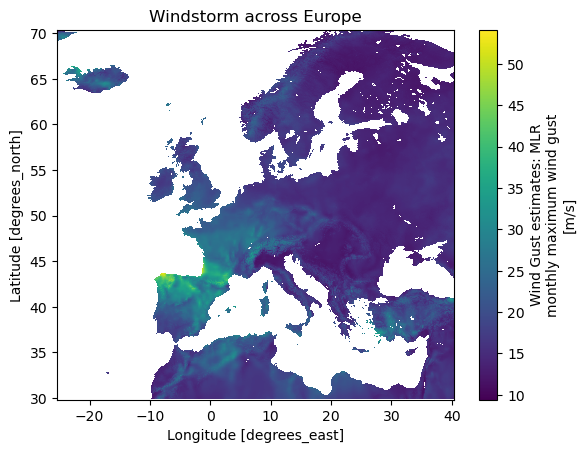
In the plot above you can see the high windspeeds of the storm light up in yellow across Europe
Exposure data#
Next we analyse the exposure data. There are datasets to analyse. First, the downloaded landcover data and then the maximum damage per landcover class.
Land cover data#
Using rioxarray, the lancover data is opened and the correct band is selected. In this case the band of interest is 1 (also the only band). Also for this dataset the crs needs to be written. From there we want to visualise the land cover map, however, since the land cover data has a detailed resolution (100mx100m) it takes a long time to plot all of Europe. That is why we clip the land use to the region of our bounding box before plotting. To match the colours on the LUISA Land Cover data portal we define a set of colours to plot the data with.
filename_land_use = f'{data_dir}/LUISA_basemap_020321_50m.tif'
land_use = rxr.open_rasterio(filename_land_use)
land_use = land_use['band'==1]
land_use = land_use.drop(['band'])
land_use.rio.write_crs(3035, inplace=True)
land_use_test_plot = land_use.rio.clip_box(*bbox,
crs="EPSG:4326")
LUISA_values = [1111,1121, 1122, 1123, 1130,
1210, 1221, 1222, 1230, 1241,
1242, 1310, 1320, 1330, 1410,
1421, 1422, 2110, 2120, 2130,
2210, 2220, 2230, 2310, 2410,
2420, 2430, 2440, 3110, 3120,
3130, 3210, 3220, 3230, 3240,
3310, 3320, 3330, 3340, 3350,
4000, 5110, 5120, 5210, 5220,
5230]
LUISA_colors = ["#8c0000", "#dc0000", "#ff6969", "#ffa0a0", "#14451a",
"#cc10dc", "#646464", "#464646", "#9c9c9c", "#828282",
"#4e4e4e", "#895a44", "#a64d00", "#cd8966", "#55ff00",
"#aaff00", "#ccb4b4", "#ffffa8", "#ffff00", "#e6e600",
"#e68000", "#f2a64d", "#e6a600", "#e6e64d", "#c3cd73",
"#ffe64d", "#e6cc4d", "#f2cca6", "#38a800", "#267300",
"#388a00", "#d3ffbe", "#cdf57a", "#a5f57a", "#89cd66",
"#e6e6e6", "#cccccc", "#ccffcc", "#000000", "#ffffff",
"#7a7aff", "#00b4f0", "#50dcf0", "#00ffa6", "#a6ffe6",
"#e6f2ff"]
# plot the land use
land_use_test_plot.plot(levels=LUISA_values, colors=LUISA_colors, figsize=(10,10))
plt.title('LUISA Land Cover for the defined area')
# we delete the map variable to save computing resources for later
del land_use_test_plot

Maximum damage per land cover class#
Next, we extract the maximum structural damage that can occur per land use class [€/m²] from the larger LUISA_damage_info_curves.xlsx sheet and save it to something we can use later. We only show the first 10 values, just to get an idea of what is in there. We see that there is quite a bit of variation in the type of landuse and the value that it has.
LUISA_info_damage_curve = pd.read_excel('LUISA_damage_info_curves.xlsx', index_col=0)
# get the maxdamage for reconstruction
maxdam = pd.DataFrame(LUISA_info_damage_curve['structural €/m²'])
maxdam.to_csv(f'{data_dir}/maxdam_luisa.csv')
maxdam.head(10)
| structural €/m² | |
|---|---|
| Land use code | |
| 1111 | 343.011305 |
| 1121 | 243.823177 |
| 1122 | 140.013142 |
| 1123 | 36.799571 |
| 1130 | 0.000000 |
| 1210 | 180.105953 |
| 1221 | 16.166945 |
| 1222 | 226.337232 |
| 1230 | 97.001671 |
| 1241 | 226.337232 |
Vulnerability#
Finaly, we inspect the vulnerability curves that we will use in the analysis. In the index we see that there is the windspeed associated with a construction class and a fraction of the buidling of a specific class that is destroyed at that wind speed. The end of the table is shown to represent fraction of the buidling that is damaged at high wind speeds.
curves_feuerstein = pd.read_csv(f'CURVES_feuerstein_koks.csv', index_col=0)
curves_feuerstein.tail()
| weakest outbuilding | outbuilding strong | outbuilding | weak brick structure | strong brick structure | concrete buidling | |
|---|---|---|---|---|---|---|
| wind speed | ||||||
| 136 | 100.0 | 100.0 | 100.0 | 100.0 | 99.50 | 85.5 |
| 137 | 100.0 | 100.0 | 100.0 | 100.0 | 99.70 | 86.1 |
| 138 | 100.0 | 100.0 | 100.0 | 100.0 | 99.90 | 86.5 |
| 139 | 100.0 | 100.0 | 100.0 | 100.0 | 99.99 | 86.8 |
| 140 | 100.0 | 100.0 | 100.0 | 100.0 | 100.00 | 87.0 |
Plotting the curves makes the damage functions more insight full. Steep curves indicate a quick change in damage with only a small change in wind speed. Flat curves indicate a small change in damage with a large change in wind speed and are therefore more resillient to high windspeeds.
curves_feuerstein.plot()
plt.title('Vulnerability curves for building construction types')
plt.ylabel('Damage (%)')
plt.xlabel('Wind speed (m/s)')
# only show legend for the first 10 entries
plt.legend(curves_feuerstein.columns[:10], loc='lower right')
<matplotlib.legend.Legend at 0x1138a3726d0>

Process the data#
In this section we will first process the data before we do our damage calculations. This is needed since the windspeed map and land cover map have different resolutions and projections meaning they do not match when we overlay them directly. Also the vulnerability curves need to be adjusted to fit with the types of buildings in the land use class.
Clipping to the region#
Before we calculate for the whole of Europe (meaning a lot of calculation time) we snip the datasets to our region of interest.
Hazard#
windstorm_region = windstorm_europe.rio.clip_box(*bbox,
crs="EPSG:4326")
windstorm_region.plot()
# we delete the map variable to save computing resources for later
del windstorm_europe
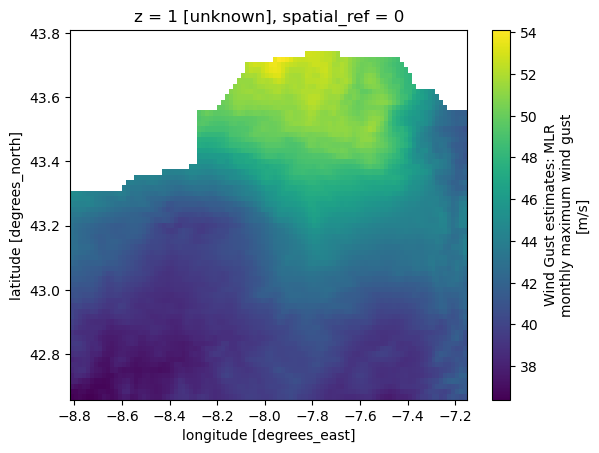
Exposure#
Since the land use data is also for the whole of Europe we clip our region to our defined bounding box too. However, we keep the land use file in its original CRS
# clip land use to the same extent as the windstorm
land_use_region = land_use.rio.clip_box(*bbox,
crs="EPSG:4326")
# Only keep values higher than 0 (no data)
land_use_region = land_use_region.where(land_use_region > 0)
land_use_region.plot(levels=LUISA_values, colors=LUISA_colors)
# we delete the map variable to save computing resources for later
del land_use
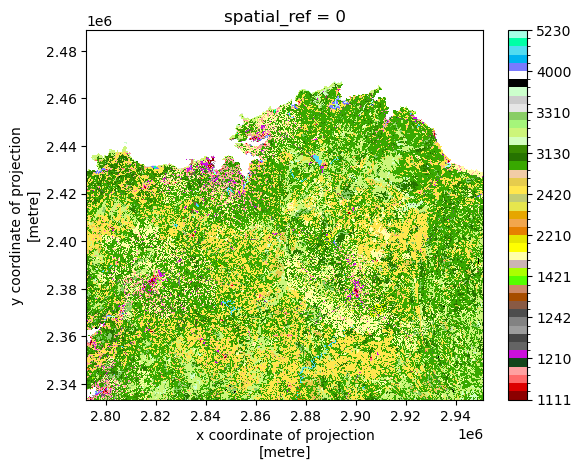
Now that we have our region of interst for the land cover. It is also interesting to see the damage potential in the region due to high wind speeds. We see that most valuable assests are located in the cities.
# assign each land use class a maxdamage value and plot this on the map
maxdam_map = land_use_region
for class_i in maxdam.index:
maxdam_map = maxdam_map.where(land_use_region != class_i, maxdam['structural €/m²'][class_i])
maxdam_map.plot(cbar_kwargs={'label': "Damage potential buildings [€/m²]"})
plt.title('Damage potential of structures in the region based on land use and maxdamages')
Text(0.5, 1.0, 'Damage potential of structures in the region based on land use and maxdamages')
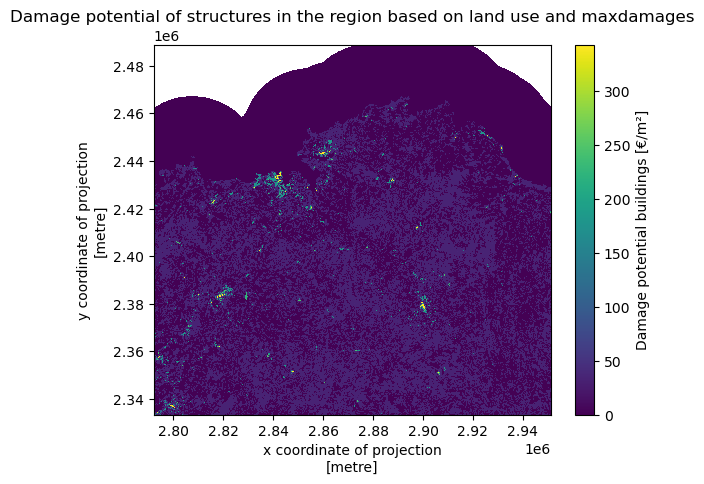
Vulenerability#
Here we will adjust the damage curves of Feurstein et al. (2011) to fit our LUISA land use map. From the Luisa info excel sheet we can retrieve a ratio of the type of buildings per land use class. If a land use class contains a lot of one certain construction type the vulnerbality curve will be close of the one represented by Feurstein et al. (2011). Otherwise it will be a curve that is a mix of the building construction types according to the ratio of structures in the land use. We see a large variation in vulnerability curves. Also some curves that are flat at 0. These represent that they are not affected by wind such as water bodies.
# create a new dataframe for damage_curves_luisa where wind and landuse classes are used
damage_curves_luisa = curves_feuerstein.copy()
# drop all columns
damage_curves_luisa.drop(damage_curves_luisa.columns, axis=1, inplace=True)
building_types = ['weakest outbuilding', 'outbuilding', 'strong outbuilding', 'weak brick structure', 'strong brick structure', 'concrete buidling']
# for each land use class in maxdamage create a new damage curve
for landuse in maxdam.index:
# find the ratio of building types in the class
ratio = LUISA_info_damage_curve.loc[landuse, building_types].values
# new curve
damage_curves_luisa[landuse] = ratio[0] * curves_feuerstein.iloc[:,0] + \
ratio[1] * curves_feuerstein.iloc[:,1] + \
ratio[2] * curves_feuerstein.iloc[:,2] + \
ratio[3] * curves_feuerstein.iloc[:,3] + \
ratio[4] * curves_feuerstein.iloc[:,4] + \
ratio[5] * curves_feuerstein.iloc[:,5]
damage_curves_luisa.to_csv(f'{data_dir}/damage_curves_luisa.csv')
damage_curves_luisa.plot()
plt.title('Vulnerability curves for wind building damage for the LUISA land cover types')
plt.ylabel('Damage (%)')
plt.xlabel('Wind speed (m/s)')
# only show legend for the first 10 entries
plt.legend(damage_curves_luisa.columns[0:10], loc='upper left')
<matplotlib.legend.Legend at 0x1138a3d7510>

Matching the two layers#
Now that the two datasets are in the same region, we can increase the resoltution of the windmap and reproject the windmap to match that of the land cover map. When increasing the resolution we need to do something with the added datapoints in our map. We can either fill these new datapoints in with whatever valaue is nearest in the orignal data set or we can interpolate the data. Choose something that makes sense. For wind data it is more logical to interpolate since abrupt changes along an arbitrary line of pixels is unlikely. However, for land use data it might make sense to choose the nearest datapoint. Otherwise the interpolation method will create new land use classes, which will be void of meaning. For example, on the edge between land use class 10 and 11 it will create 10.5 or between class 1 and 10 it will set pixels to 5 without the pixel actually being class 5.
from rasterio.enums import Resampling
windstorm_region_matched = windstorm_region.rio.reproject_match(land_use_region, resampling = Resampling.cubic) # can also be .nearest or
windstorm_region_matched = windstorm_region_matched.assign_coords({
"x": land_use_region.x,
"y": land_use_region.y,
})
# plot windstorm_region and windstorm_region_matched next to each other
fig, (ax1, ax2) = plt.subplots(nrows=1, ncols=2, figsize=(20, 5))
windstorm_region.plot(ax=ax1)
ax1.set_title("Original windstorm data")
windstorm_region_matched.plot(ax=ax2)
ax2.set_title("Windstorm data matched to land use data")
# we delete the map variable to save computing resources for later
del windstorm_region

We find two things. Firstly, the map is skewed due to our reprojection and secondly the map is smoother than the original dataset due to our Resampling method.
Now we can overlay the two images to get a quick look at where high windspeeds are and where certain land cover classes are. We see that there is some mismathc between the maps due to our reprojection. When the damage estimates are calculated only values are calculated for the locations where both maps overlap
# plot
fig, ax = plt.subplots()
windstorm_region_matched.plot(ax=ax, cmap='viridis', alpha=1)
land_use_region.plot(ax=ax, levels=LUISA_values, colors=LUISA_colors, alpha=0.7)
ax.set_title('Windstorm and land use 2018')
Text(0.5, 1.0, 'Windstorm and land use 2018')

Note! Because the used DamageScanner package uses the resolution of the maps to calculate the area in m² it is important that both maps are in a CRS that uses meters instead of degrees.
# set the correct order of the coordinates in the data set
windstorm_region_matched.transpose('y', 'x')
land_use_region=land_use_region.transpose('y', 'x')
Now we save the raster maps of the windstorm and land use to .tif files so these can be used in the damage calculation
windstorm_region_matched.rio.to_raster(f'{data_dir}/windstorm_region_matched.tif')
land_use_region.rio.to_raster(f'{data_dir}/land_use_region.tif')
Calculate structural damage#
Now that we have everything ready, we can do the damage calculation using the RasterScanner function from the DamageScanner python package. Making the
# code for the calculation
wind_map = os.path.join(data_dir,'windstorm_region_matched.tif')
landuse_map = os.path.join(data_dir,'land_use_region.tif')
curve_path = os.path.join(f'{data_dir}/damage_curves_luisa.csv')
maxdam_path = os.path.join(f'{data_dir}/maxdam_luisa.csv')
damage_catagory, _, _, _ = RasterScanner(landuse_file = landuse_map,
hazard_file = wind_map,
curve_path = curve_path,
maxdam_path = maxdam_path,
scenario_name= f'{results_dir}/Windstorm_Klaus_Catalunya',
lu_crs=land_use_region.rio.crs,
haz_crs=windstorm_region_matched.rio.crs,
in_millions = False,
dtype = np.int64, # if set to int32 it gives an error
save=True)
Plot the results#
From the results we can obtain the total damages in the area per land cover class. We first check the summed damage for each land use class. Land cover classes can obtain high damages because they are either valuable per m² or a lot of area in the region is of a certain land cover. For example, large but not as valuable land can still have a higher damage total than small but very valuable land.
damage_catagory.T
| landuse | 1111 | 1121 | 1122 | 1123 | 1130 | 1210 | 1221 | 1222 | 1230 | 1241 | ... | 3320 | 3330 | 3340 | 3350 | 4000 | 5110 | 5120 | 5210 | 5220 | 5230 |
|---|---|---|---|---|---|---|---|---|---|---|---|---|---|---|---|---|---|---|---|---|---|
| damages | 659.579095 | 1127.979486 | 3231.020165 | 27107.413124 | 0.0 | 104466.834403 | 12401.680568 | 0.0 | 6178.64627 | 628.732501 | ... | 1838.943362 | 9247.204841 | 54.865202 | 0.0 | 43182.59105 | 0.0 | 0.0 | 0.0 | 0.0 | 0.0 |
1 rows × 46 columns
# we calculate the total damage in the region of the event in millions of euros
print(f"Total damages in the region [mln. €]: { damage_catagory.sum().values[0] / 10 ** 6}")
Total damages in the region [mln. €]: 8.523841995406002
Now we will plot the damages on a map to gain more insight where the storm caused most damage. First we plot pure economic value that is affected and then we asses which location are relatively hit the hardest by a wind storm by representing the manifested structural damage versus the maximum structural damage.
# import the saved damagemap into python
damage_map = rxr.open_rasterio(f'{results_dir}/Windstorm_Klaus_Catalunya_damagemap.tif')
# Currently the damages are represented in total damage of a grid cell so we change it to represent damage per m2
damage_map_adjusted = damage_map / (abs(damage_map.rio.resolution()[0] * damage_map.rio.resolution()[1]))
# create figure
fig, ax = plt.subplots(figsize=(12, 6))
damage_map_adjusted = damage_map_adjusted.where(damage_map_adjusted > 0)
damage_map_adjusted.plot(ax=ax, cmap='Reds', cbar_kwargs={'label': "Structural damage [€/m²]"})
plt.title('Structural damage map for the region in the selected storm event')
# add basemap from openstreetmap
ctx.add_basemap(ax, crs=damage_map_adjusted.rio.crs.to_string(), alpha=1, source=ctx.providers.CartoDB.Positron)
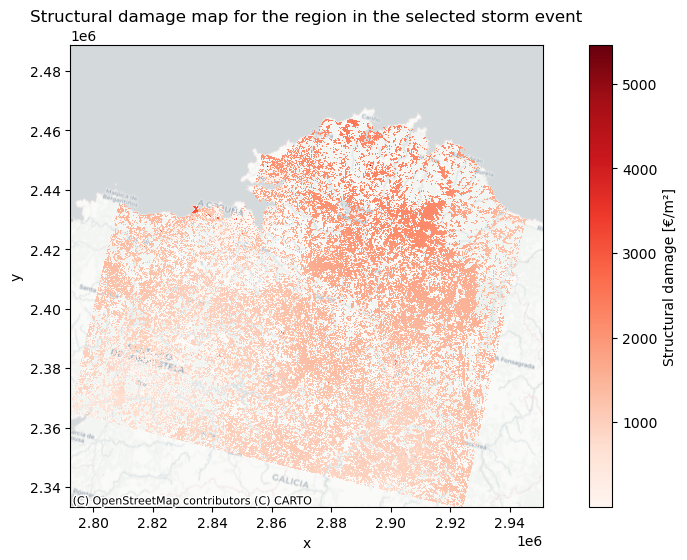
# plot the relative damage for each land use class
fig, ax = plt.subplots(figsize=(12, 6))
# set figure size
relative_damage = damage_map_adjusted / maxdam_map
# filter out assests that do not have a damage potential
relative_damage = relative_damage.where(relative_damage > 0)
relative_damage.plot(ax=ax, cmap='Reds', cbar_kwargs={'label': "Relative structural damage [%]"})
plt.title('Relative structural damage map for the region in the selected storm event')
# add basemap from openstreetmap
ctx.add_basemap(ax, crs=relative_damage.rio.crs.to_string(), alpha=0.5, source=ctx.providers.CartoDB.Positron)
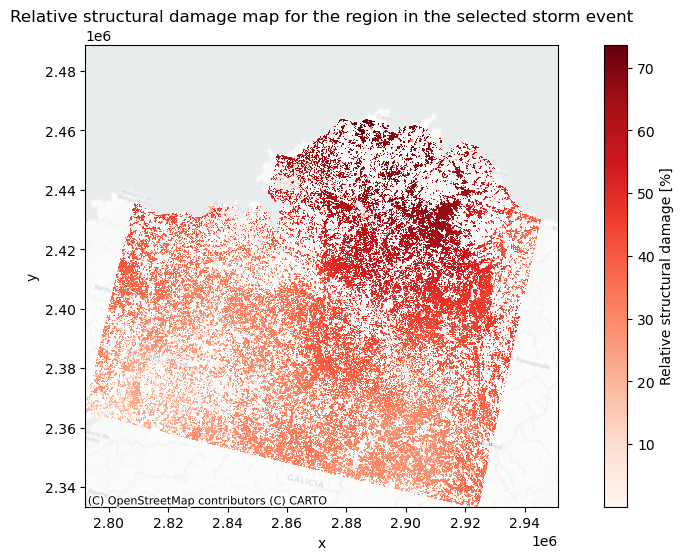
Conclusions#
In this risk assessment workflow we learned how to match event and land cover maps so they can be put into the damagescanner function. We then visualised the damage estimation for a storm using pure economic damage and then using relative structural damage.
Contributors#
Authors:
Ted Buskop (Deltares & Vrije Universiteit Amsterdam, IVM)
References:
Koks, E.E., Haer., T. A high-resolution wind damage model for Europe. Sci Rep 10, 6866 (2020). https://doi.org/10.1038/s41598-020-63580-w
Copernicus Climate Change Service, Climate Data Store, (2022): Winter windstorm indicators for Europe from 1979 to 2021 derived from reanalysis. Copernicus Climate Change Service (C3S) Climate Data Store (CDS). DOI: 10.24381/cds.9b4ea013 (Accessed on DD-MMM-YYYY)
Copernicus Climate Change Service, Climate Data Store, (2022): Synthetic windstorm events for Europe from 1986 to 2011. Copernicus Climate Change Service (C3S) Climate Data Store (CDS). DOI: 10.24381/cds.ce973f02 (Accessed on DD-MMM-YYYY)
Feuerstein, B., Groenemeijer, P., Dirksen, E., Hubrig, M., Holzer, A. M., & Dotzek, N. (2011). Towards an improved wind speed scale and damage description adapted for Central Europe. Atmospheric Research, 100(4), 547-564. https://doi.org/10.1016/j.atmosres.2010.12.026
Pigaiani, C. and Batista E Silva, F., The LUISA Base Map 2018, EUR 30663 EN, Publications Office of the European Union, Luxembourg, 2021, ISBN 978-92-76-34207-6, https://doi.org/10.2760/503006, JRC124621.
